USQ ACC5216 Accounting Theory: Stakeholder & Legitimacy Theories
VerifiedAdded on 2023/06/14
|9
|2117
|248
Report
AI Summary
This report delves into accounting theory by examining the case of the National Australia Bank (NAB), which announced significant job cuts despite reporting substantial profits. The analysis focuses on stakeholder and legitimacy theories, exploring how NAB's actions impact various stakeholders, including employees, shareholders, business partners, and customers. It compares and contrasts these theories, arguing that stakeholder theory, with its emphasis on economic motivations, is more relevant for banks in the current corporate environment. The report concludes that NAB's decision, while aimed at cost-cutting and technological advancement, led to a decline in share price due to a failure to adequately address stakeholder concerns, highlighting the importance of stakeholder management in contemporary business.

qwertyuiopasdfghjklzxcvbnmqw
ertyuiopasdfghjklzxcvbnmqwert
yuiopasdfghjklzxcvbnmqwertyui
opasdfghjklzxcvbnmqwertyuiopa
sdfghjklzxcvbnmqwertyuiopasdf
ghjklzxcvbnmqwertyuiopasdfghj
klzxcvbnmqwertyuiopasdfghjklz
xcvbnmqwertyuiopasdfghjklzxcv
bnmqwertyuiopasdfghjklzxcvbn
mqwertyuiopasdfghjklzxcvbnmq
wertyuiopasdfghjklzxcvbnmqwer
tyuiopasdfghjklzxcvbnmqwertyui
opasdfghjklzxcvbnmqwertyuiopa
sdfghjklzxcvbnmqwertyuiopasdf
ghjklzxcvbnmqwertyuiopasdfghj
klzxcvbnmqwertyuiopasdfghjklz
xcvbnmrtyuiopasdfghjklzxcvbnm
qwertyuiopasdfghjklzxcvbnmqw
ACCOUNTING THEORY
ertyuiopasdfghjklzxcvbnmqwert
yuiopasdfghjklzxcvbnmqwertyui
opasdfghjklzxcvbnmqwertyuiopa
sdfghjklzxcvbnmqwertyuiopasdf
ghjklzxcvbnmqwertyuiopasdfghj
klzxcvbnmqwertyuiopasdfghjklz
xcvbnmqwertyuiopasdfghjklzxcv
bnmqwertyuiopasdfghjklzxcvbn
mqwertyuiopasdfghjklzxcvbnmq
wertyuiopasdfghjklzxcvbnmqwer
tyuiopasdfghjklzxcvbnmqwertyui
opasdfghjklzxcvbnmqwertyuiopa
sdfghjklzxcvbnmqwertyuiopasdf
ghjklzxcvbnmqwertyuiopasdfghj
klzxcvbnmqwertyuiopasdfghjklz
xcvbnmrtyuiopasdfghjklzxcvbnm
qwertyuiopasdfghjklzxcvbnmqw
ACCOUNTING THEORY
Paraphrase This Document
Need a fresh take? Get an instant paraphrase of this document with our AI Paraphraser
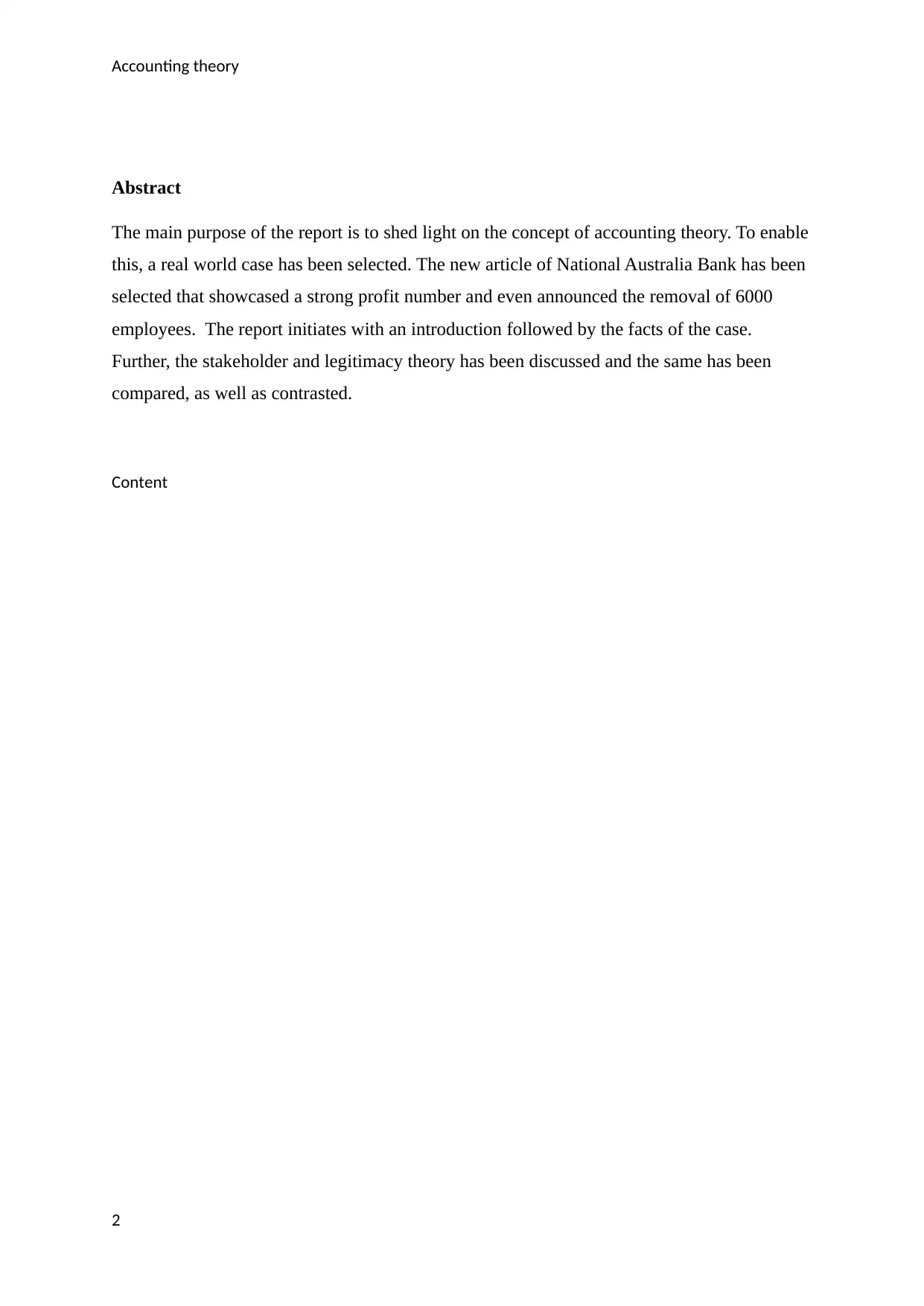
Accounting theory
Abstract
The main purpose of the report is to shed light on the concept of accounting theory. To enable
this, a real world case has been selected. The new article of National Australia Bank has been
selected that showcased a strong profit number and even announced the removal of 6000
employees. The report initiates with an introduction followed by the facts of the case.
Further, the stakeholder and legitimacy theory has been discussed and the same has been
compared, as well as contrasted.
Content
2
Abstract
The main purpose of the report is to shed light on the concept of accounting theory. To enable
this, a real world case has been selected. The new article of National Australia Bank has been
selected that showcased a strong profit number and even announced the removal of 6000
employees. The report initiates with an introduction followed by the facts of the case.
Further, the stakeholder and legitimacy theory has been discussed and the same has been
compared, as well as contrasted.
Content
2
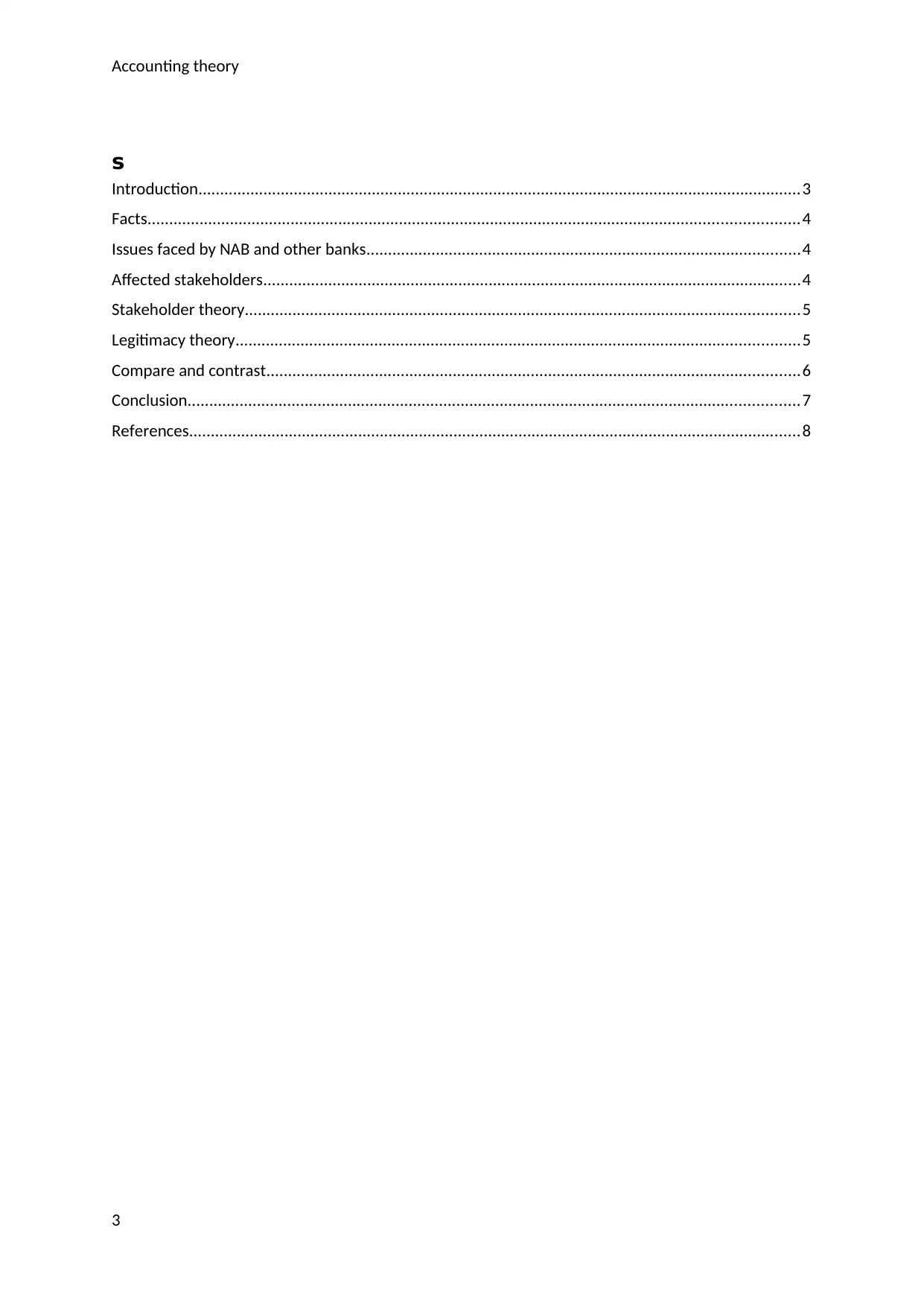
Accounting theory
s
Introduction...........................................................................................................................................3
Facts......................................................................................................................................................4
Issues faced by NAB and other banks....................................................................................................4
Affected stakeholders............................................................................................................................4
Stakeholder theory................................................................................................................................5
Legitimacy theory..................................................................................................................................5
Compare and contrast...........................................................................................................................6
Conclusion.............................................................................................................................................7
References.............................................................................................................................................8
3
s
Introduction...........................................................................................................................................3
Facts......................................................................................................................................................4
Issues faced by NAB and other banks....................................................................................................4
Affected stakeholders............................................................................................................................4
Stakeholder theory................................................................................................................................5
Legitimacy theory..................................................................................................................................5
Compare and contrast...........................................................................................................................6
Conclusion.............................................................................................................................................7
References.............................................................................................................................................8
3
⊘ This is a preview!⊘
Do you want full access?
Subscribe today to unlock all pages.

Trusted by 1+ million students worldwide
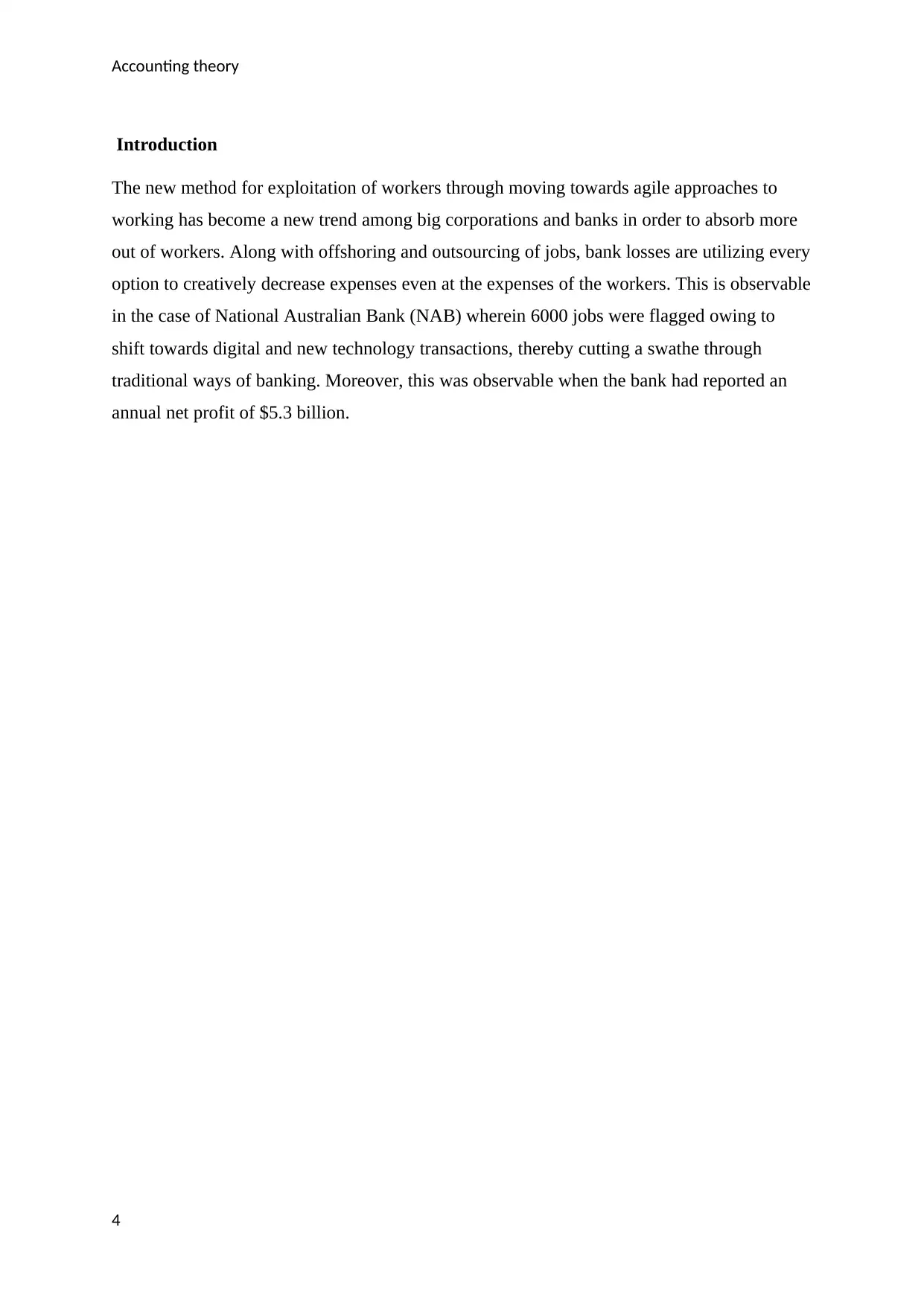
Accounting theory
Introduction
The new method for exploitation of workers through moving towards agile approaches to
working has become a new trend among big corporations and banks in order to absorb more
out of workers. Along with offshoring and outsourcing of jobs, bank losses are utilizing every
option to creatively decrease expenses even at the expenses of the workers. This is observable
in the case of National Australian Bank (NAB) wherein 6000 jobs were flagged owing to
shift towards digital and new technology transactions, thereby cutting a swathe through
traditional ways of banking. Moreover, this was observable when the bank had reported an
annual net profit of $5.3 billion.
4
Introduction
The new method for exploitation of workers through moving towards agile approaches to
working has become a new trend among big corporations and banks in order to absorb more
out of workers. Along with offshoring and outsourcing of jobs, bank losses are utilizing every
option to creatively decrease expenses even at the expenses of the workers. This is observable
in the case of National Australian Bank (NAB) wherein 6000 jobs were flagged owing to
shift towards digital and new technology transactions, thereby cutting a swathe through
traditional ways of banking. Moreover, this was observable when the bank had reported an
annual net profit of $5.3 billion.
4
Paraphrase This Document
Need a fresh take? Get an instant paraphrase of this document with our AI Paraphraser
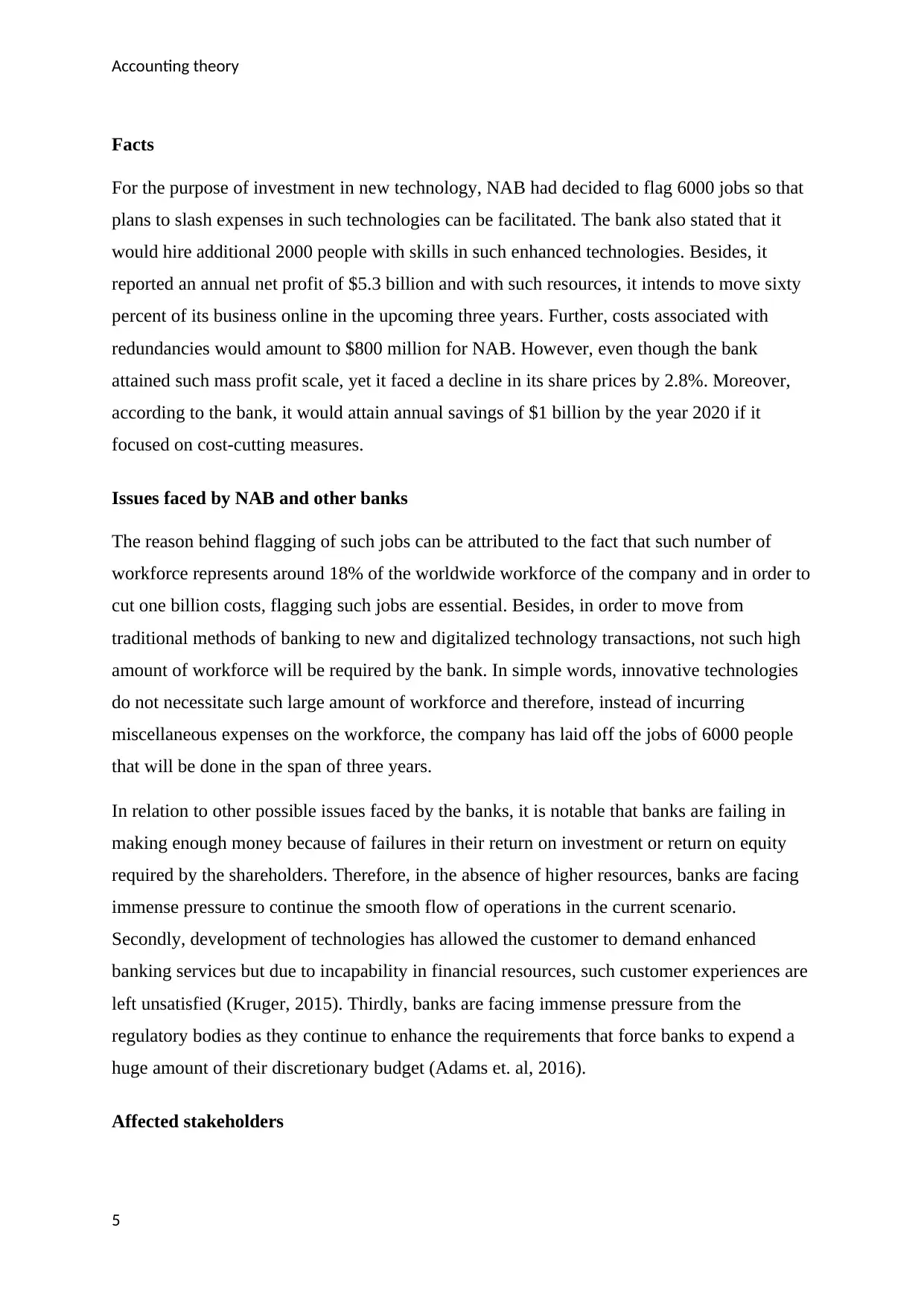
Accounting theory
Facts
For the purpose of investment in new technology, NAB had decided to flag 6000 jobs so that
plans to slash expenses in such technologies can be facilitated. The bank also stated that it
would hire additional 2000 people with skills in such enhanced technologies. Besides, it
reported an annual net profit of $5.3 billion and with such resources, it intends to move sixty
percent of its business online in the upcoming three years. Further, costs associated with
redundancies would amount to $800 million for NAB. However, even though the bank
attained such mass profit scale, yet it faced a decline in its share prices by 2.8%. Moreover,
according to the bank, it would attain annual savings of $1 billion by the year 2020 if it
focused on cost-cutting measures.
Issues faced by NAB and other banks
The reason behind flagging of such jobs can be attributed to the fact that such number of
workforce represents around 18% of the worldwide workforce of the company and in order to
cut one billion costs, flagging such jobs are essential. Besides, in order to move from
traditional methods of banking to new and digitalized technology transactions, not such high
amount of workforce will be required by the bank. In simple words, innovative technologies
do not necessitate such large amount of workforce and therefore, instead of incurring
miscellaneous expenses on the workforce, the company has laid off the jobs of 6000 people
that will be done in the span of three years.
In relation to other possible issues faced by the banks, it is notable that banks are failing in
making enough money because of failures in their return on investment or return on equity
required by the shareholders. Therefore, in the absence of higher resources, banks are facing
immense pressure to continue the smooth flow of operations in the current scenario.
Secondly, development of technologies has allowed the customer to demand enhanced
banking services but due to incapability in financial resources, such customer experiences are
left unsatisfied (Kruger, 2015). Thirdly, banks are facing immense pressure from the
regulatory bodies as they continue to enhance the requirements that force banks to expend a
huge amount of their discretionary budget (Adams et. al, 2016).
Affected stakeholders
5
Facts
For the purpose of investment in new technology, NAB had decided to flag 6000 jobs so that
plans to slash expenses in such technologies can be facilitated. The bank also stated that it
would hire additional 2000 people with skills in such enhanced technologies. Besides, it
reported an annual net profit of $5.3 billion and with such resources, it intends to move sixty
percent of its business online in the upcoming three years. Further, costs associated with
redundancies would amount to $800 million for NAB. However, even though the bank
attained such mass profit scale, yet it faced a decline in its share prices by 2.8%. Moreover,
according to the bank, it would attain annual savings of $1 billion by the year 2020 if it
focused on cost-cutting measures.
Issues faced by NAB and other banks
The reason behind flagging of such jobs can be attributed to the fact that such number of
workforce represents around 18% of the worldwide workforce of the company and in order to
cut one billion costs, flagging such jobs are essential. Besides, in order to move from
traditional methods of banking to new and digitalized technology transactions, not such high
amount of workforce will be required by the bank. In simple words, innovative technologies
do not necessitate such large amount of workforce and therefore, instead of incurring
miscellaneous expenses on the workforce, the company has laid off the jobs of 6000 people
that will be done in the span of three years.
In relation to other possible issues faced by the banks, it is notable that banks are failing in
making enough money because of failures in their return on investment or return on equity
required by the shareholders. Therefore, in the absence of higher resources, banks are facing
immense pressure to continue the smooth flow of operations in the current scenario.
Secondly, development of technologies has allowed the customer to demand enhanced
banking services but due to incapability in financial resources, such customer experiences are
left unsatisfied (Kruger, 2015). Thirdly, banks are facing immense pressure from the
regulatory bodies as they continue to enhance the requirements that force banks to expend a
huge amount of their discretionary budget (Adams et. al, 2016).
Affected stakeholders
5
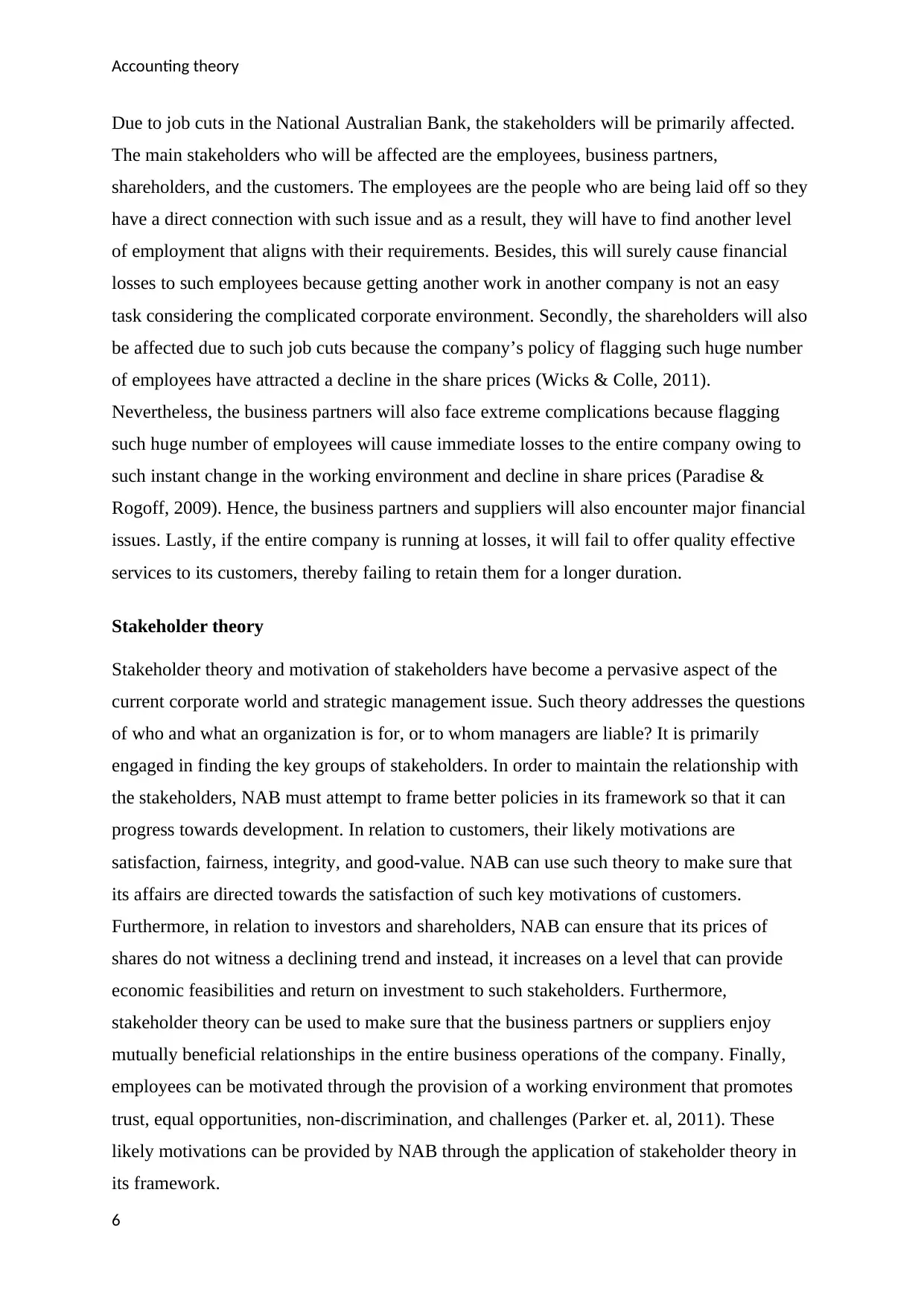
Accounting theory
Due to job cuts in the National Australian Bank, the stakeholders will be primarily affected.
The main stakeholders who will be affected are the employees, business partners,
shareholders, and the customers. The employees are the people who are being laid off so they
have a direct connection with such issue and as a result, they will have to find another level
of employment that aligns with their requirements. Besides, this will surely cause financial
losses to such employees because getting another work in another company is not an easy
task considering the complicated corporate environment. Secondly, the shareholders will also
be affected due to such job cuts because the company’s policy of flagging such huge number
of employees have attracted a decline in the share prices (Wicks & Colle, 2011).
Nevertheless, the business partners will also face extreme complications because flagging
such huge number of employees will cause immediate losses to the entire company owing to
such instant change in the working environment and decline in share prices (Paradise &
Rogoff, 2009). Hence, the business partners and suppliers will also encounter major financial
issues. Lastly, if the entire company is running at losses, it will fail to offer quality effective
services to its customers, thereby failing to retain them for a longer duration.
Stakeholder theory
Stakeholder theory and motivation of stakeholders have become a pervasive aspect of the
current corporate world and strategic management issue. Such theory addresses the questions
of who and what an organization is for, or to whom managers are liable? It is primarily
engaged in finding the key groups of stakeholders. In order to maintain the relationship with
the stakeholders, NAB must attempt to frame better policies in its framework so that it can
progress towards development. In relation to customers, their likely motivations are
satisfaction, fairness, integrity, and good-value. NAB can use such theory to make sure that
its affairs are directed towards the satisfaction of such key motivations of customers.
Furthermore, in relation to investors and shareholders, NAB can ensure that its prices of
shares do not witness a declining trend and instead, it increases on a level that can provide
economic feasibilities and return on investment to such stakeholders. Furthermore,
stakeholder theory can be used to make sure that the business partners or suppliers enjoy
mutually beneficial relationships in the entire business operations of the company. Finally,
employees can be motivated through the provision of a working environment that promotes
trust, equal opportunities, non-discrimination, and challenges (Parker et. al, 2011). These
likely motivations can be provided by NAB through the application of stakeholder theory in
its framework.
6
Due to job cuts in the National Australian Bank, the stakeholders will be primarily affected.
The main stakeholders who will be affected are the employees, business partners,
shareholders, and the customers. The employees are the people who are being laid off so they
have a direct connection with such issue and as a result, they will have to find another level
of employment that aligns with their requirements. Besides, this will surely cause financial
losses to such employees because getting another work in another company is not an easy
task considering the complicated corporate environment. Secondly, the shareholders will also
be affected due to such job cuts because the company’s policy of flagging such huge number
of employees have attracted a decline in the share prices (Wicks & Colle, 2011).
Nevertheless, the business partners will also face extreme complications because flagging
such huge number of employees will cause immediate losses to the entire company owing to
such instant change in the working environment and decline in share prices (Paradise &
Rogoff, 2009). Hence, the business partners and suppliers will also encounter major financial
issues. Lastly, if the entire company is running at losses, it will fail to offer quality effective
services to its customers, thereby failing to retain them for a longer duration.
Stakeholder theory
Stakeholder theory and motivation of stakeholders have become a pervasive aspect of the
current corporate world and strategic management issue. Such theory addresses the questions
of who and what an organization is for, or to whom managers are liable? It is primarily
engaged in finding the key groups of stakeholders. In order to maintain the relationship with
the stakeholders, NAB must attempt to frame better policies in its framework so that it can
progress towards development. In relation to customers, their likely motivations are
satisfaction, fairness, integrity, and good-value. NAB can use such theory to make sure that
its affairs are directed towards the satisfaction of such key motivations of customers.
Furthermore, in relation to investors and shareholders, NAB can ensure that its prices of
shares do not witness a declining trend and instead, it increases on a level that can provide
economic feasibilities and return on investment to such stakeholders. Furthermore,
stakeholder theory can be used to make sure that the business partners or suppliers enjoy
mutually beneficial relationships in the entire business operations of the company. Finally,
employees can be motivated through the provision of a working environment that promotes
trust, equal opportunities, non-discrimination, and challenges (Parker et. al, 2011). These
likely motivations can be provided by NAB through the application of stakeholder theory in
its framework.
6
⊘ This is a preview!⊘
Do you want full access?
Subscribe today to unlock all pages.

Trusted by 1+ million students worldwide
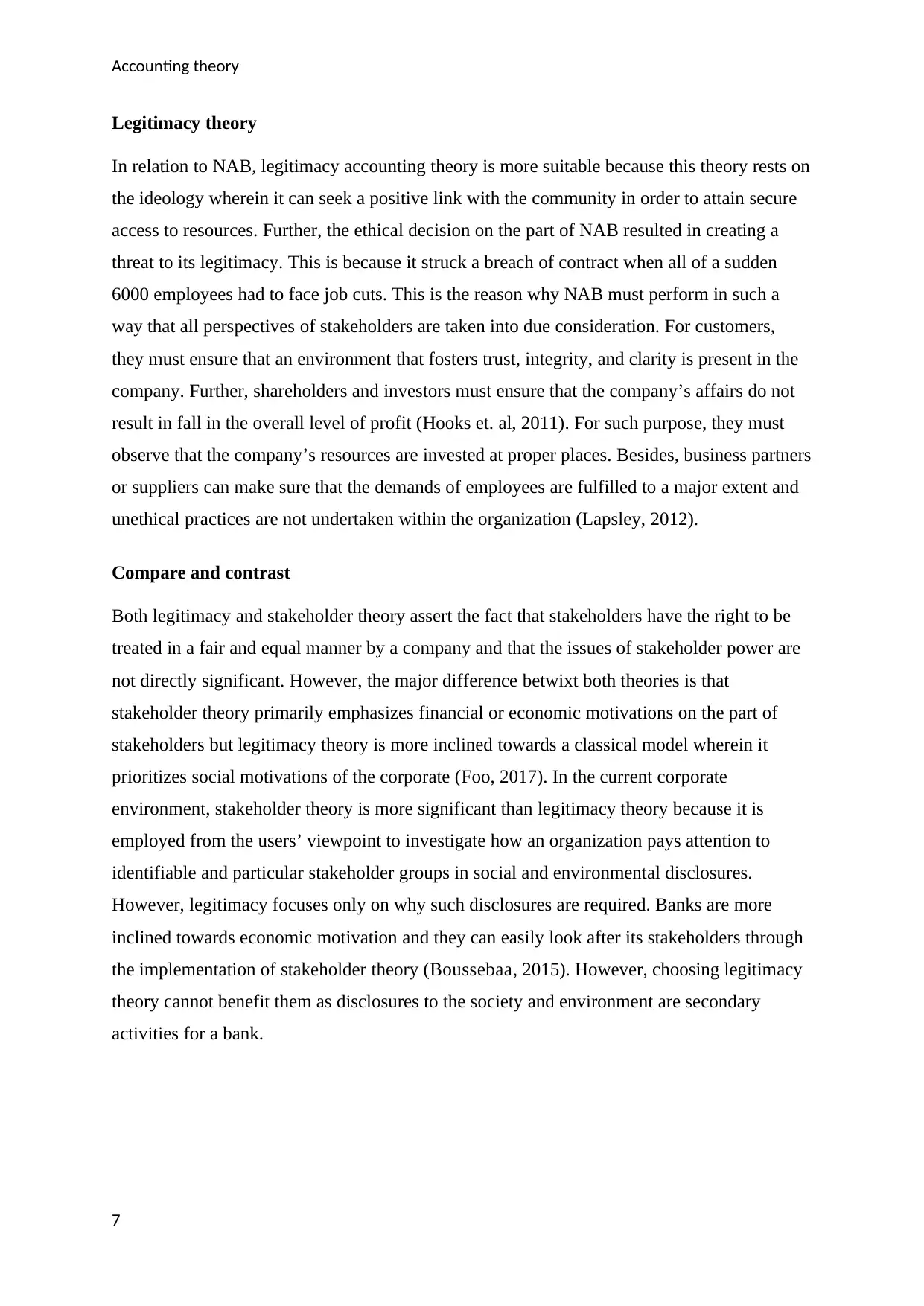
Accounting theory
Legitimacy theory
In relation to NAB, legitimacy accounting theory is more suitable because this theory rests on
the ideology wherein it can seek a positive link with the community in order to attain secure
access to resources. Further, the ethical decision on the part of NAB resulted in creating a
threat to its legitimacy. This is because it struck a breach of contract when all of a sudden
6000 employees had to face job cuts. This is the reason why NAB must perform in such a
way that all perspectives of stakeholders are taken into due consideration. For customers,
they must ensure that an environment that fosters trust, integrity, and clarity is present in the
company. Further, shareholders and investors must ensure that the company’s affairs do not
result in fall in the overall level of profit (Hooks et. al, 2011). For such purpose, they must
observe that the company’s resources are invested at proper places. Besides, business partners
or suppliers can make sure that the demands of employees are fulfilled to a major extent and
unethical practices are not undertaken within the organization (Lapsley, 2012).
Compare and contrast
Both legitimacy and stakeholder theory assert the fact that stakeholders have the right to be
treated in a fair and equal manner by a company and that the issues of stakeholder power are
not directly significant. However, the major difference betwixt both theories is that
stakeholder theory primarily emphasizes financial or economic motivations on the part of
stakeholders but legitimacy theory is more inclined towards a classical model wherein it
prioritizes social motivations of the corporate (Foo, 2017). In the current corporate
environment, stakeholder theory is more significant than legitimacy theory because it is
employed from the users’ viewpoint to investigate how an organization pays attention to
identifiable and particular stakeholder groups in social and environmental disclosures.
However, legitimacy focuses only on why such disclosures are required. Banks are more
inclined towards economic motivation and they can easily look after its stakeholders through
the implementation of stakeholder theory (Boussebaa, 2015). However, choosing legitimacy
theory cannot benefit them as disclosures to the society and environment are secondary
activities for a bank.
7
Legitimacy theory
In relation to NAB, legitimacy accounting theory is more suitable because this theory rests on
the ideology wherein it can seek a positive link with the community in order to attain secure
access to resources. Further, the ethical decision on the part of NAB resulted in creating a
threat to its legitimacy. This is because it struck a breach of contract when all of a sudden
6000 employees had to face job cuts. This is the reason why NAB must perform in such a
way that all perspectives of stakeholders are taken into due consideration. For customers,
they must ensure that an environment that fosters trust, integrity, and clarity is present in the
company. Further, shareholders and investors must ensure that the company’s affairs do not
result in fall in the overall level of profit (Hooks et. al, 2011). For such purpose, they must
observe that the company’s resources are invested at proper places. Besides, business partners
or suppliers can make sure that the demands of employees are fulfilled to a major extent and
unethical practices are not undertaken within the organization (Lapsley, 2012).
Compare and contrast
Both legitimacy and stakeholder theory assert the fact that stakeholders have the right to be
treated in a fair and equal manner by a company and that the issues of stakeholder power are
not directly significant. However, the major difference betwixt both theories is that
stakeholder theory primarily emphasizes financial or economic motivations on the part of
stakeholders but legitimacy theory is more inclined towards a classical model wherein it
prioritizes social motivations of the corporate (Foo, 2017). In the current corporate
environment, stakeholder theory is more significant than legitimacy theory because it is
employed from the users’ viewpoint to investigate how an organization pays attention to
identifiable and particular stakeholder groups in social and environmental disclosures.
However, legitimacy focuses only on why such disclosures are required. Banks are more
inclined towards economic motivation and they can easily look after its stakeholders through
the implementation of stakeholder theory (Boussebaa, 2015). However, choosing legitimacy
theory cannot benefit them as disclosures to the society and environment are secondary
activities for a bank.
7
Paraphrase This Document
Need a fresh take? Get an instant paraphrase of this document with our AI Paraphraser
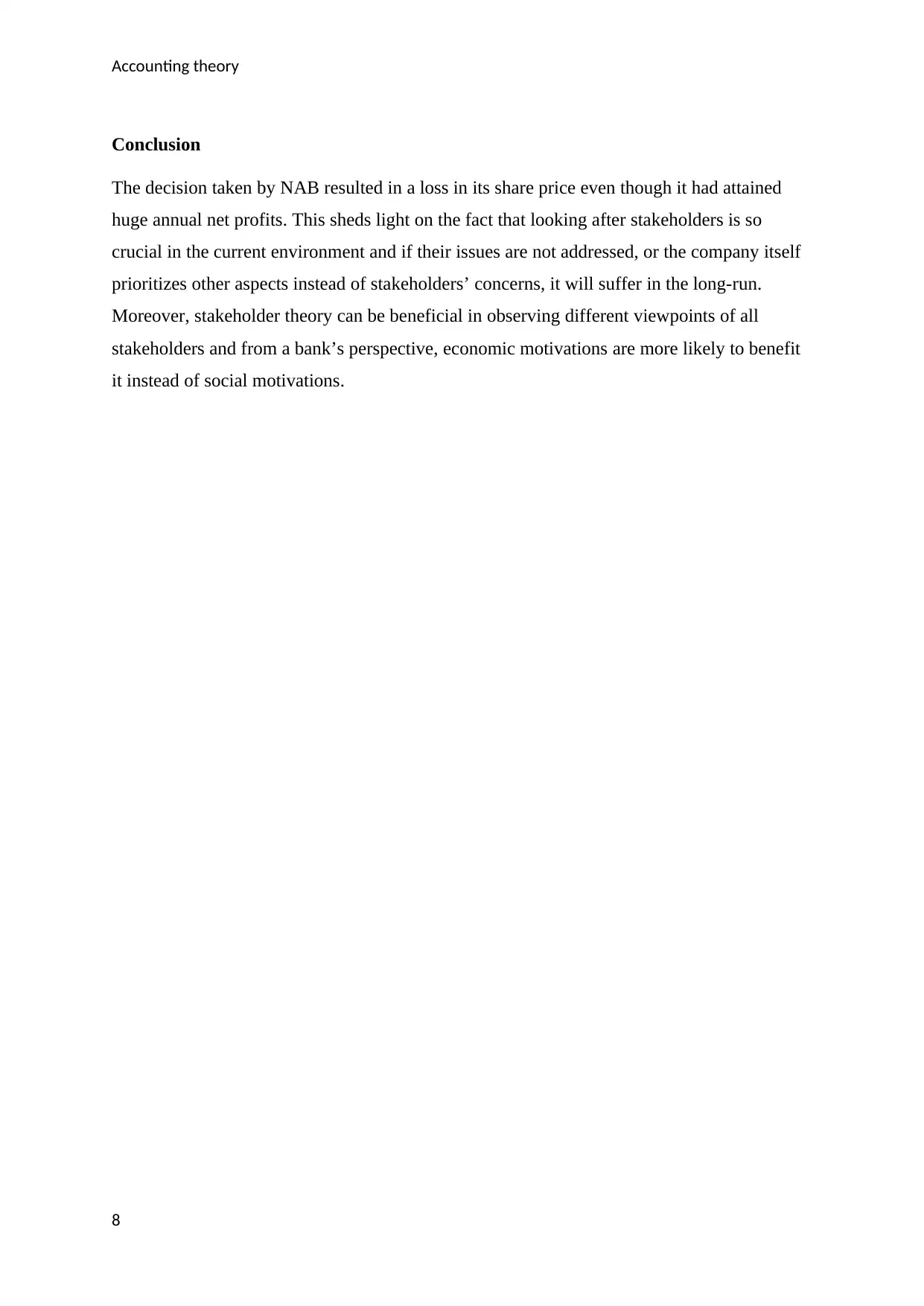
Accounting theory
Conclusion
The decision taken by NAB resulted in a loss in its share price even though it had attained
huge annual net profits. This sheds light on the fact that looking after stakeholders is so
crucial in the current environment and if their issues are not addressed, or the company itself
prioritizes other aspects instead of stakeholders’ concerns, it will suffer in the long-run.
Moreover, stakeholder theory can be beneficial in observing different viewpoints of all
stakeholders and from a bank’s perspective, economic motivations are more likely to benefit
it instead of social motivations.
8
Conclusion
The decision taken by NAB resulted in a loss in its share price even though it had attained
huge annual net profits. This sheds light on the fact that looking after stakeholders is so
crucial in the current environment and if their issues are not addressed, or the company itself
prioritizes other aspects instead of stakeholders’ concerns, it will suffer in the long-run.
Moreover, stakeholder theory can be beneficial in observing different viewpoints of all
stakeholders and from a bank’s perspective, economic motivations are more likely to benefit
it instead of social motivations.
8
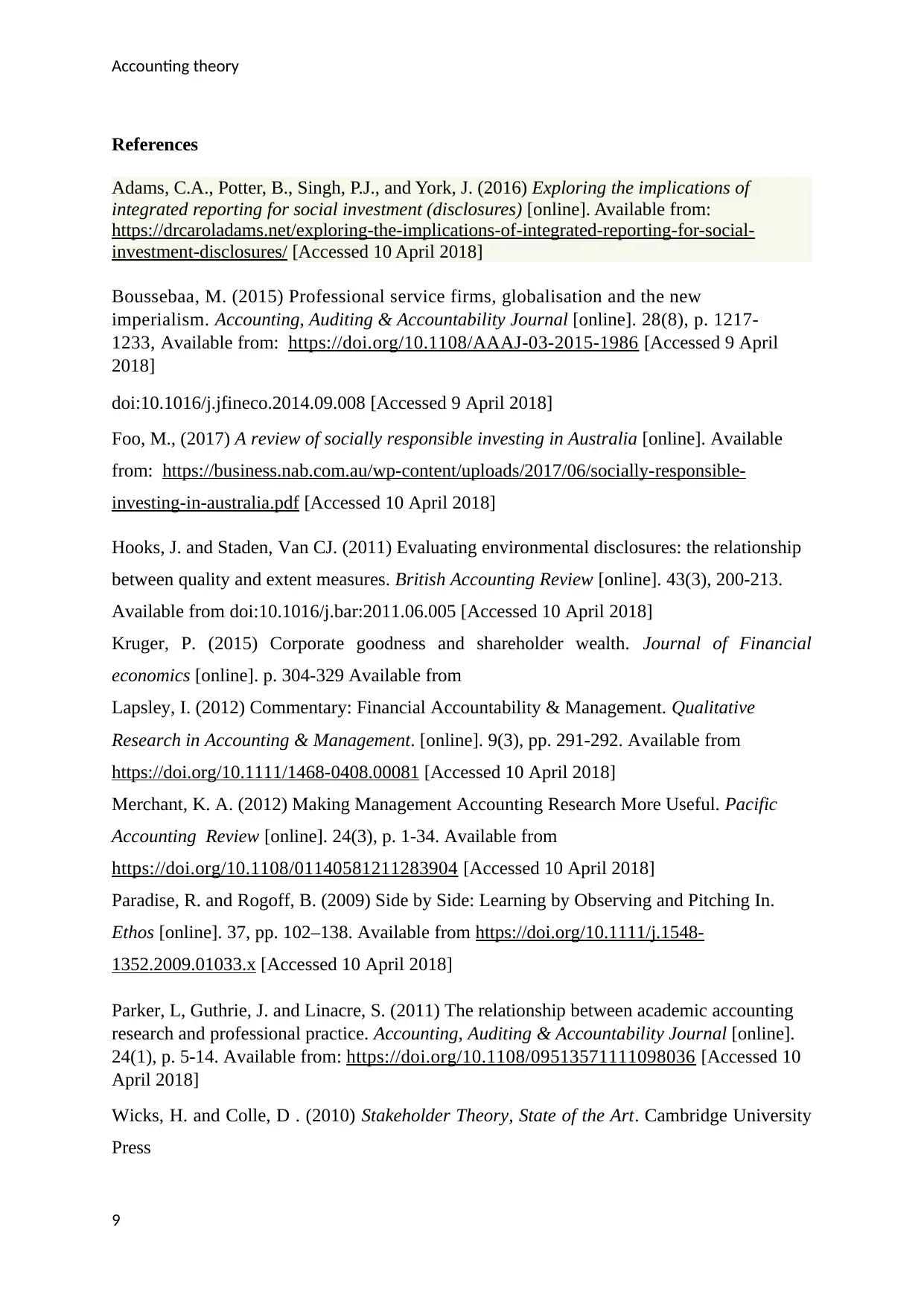
Accounting theory
References
Adams, C.A., Potter, B., Singh, P.J., and York, J. (2016) Exploring the implications of
integrated reporting for social investment (disclosures) [online]. Available from:
https://drcaroladams.net/exploring-the-implications-of-integrated-reporting-for-social-
investment-disclosures/ [Accessed 10 April 2018]
Boussebaa, M. (2015) Professional service firms, globalisation and the new
imperialism. Accounting, Auditing & Accountability Journal [online]. 28(8), p. 1217-
1233, Available from: https://doi.org/10.1108/AAAJ-03-2015-1986 [Accessed 9 April
2018]
doi:10.1016/j.jfineco.2014.09.008 [Accessed 9 April 2018]
Foo, M., (2017) A review of socially responsible investing in Australia [online]. Available
from: https://business.nab.com.au/wp-content/uploads/2017/06/socially-responsible-
investing-in-australia.pdf [Accessed 10 April 2018]
Hooks, J. and Staden, Van CJ. (2011) Evaluating environmental disclosures: the relationship
between quality and extent measures. British Accounting Review [online]. 43(3), 200-213.
Available from doi:10.1016/j.bar:2011.06.005 [Accessed 10 April 2018]
Kruger, P. (2015) Corporate goodness and shareholder wealth. Journal of Financial
economics [online]. p. 304-329 Available from
Lapsley, I. (2012) Commentary: Financial Accountability & Management. Qualitative
Research in Accounting & Management. [online]. 9(3), pp. 291-292. Available from
https://doi.org/10.1111/1468-0408.00081 [Accessed 10 April 2018]
Merchant, K. A. (2012) Making Management Accounting Research More Useful. Pacific
Accounting Review [online]. 24(3), p. 1-34. Available from
https://doi.org/10.1108/01140581211283904 [Accessed 10 April 2018]
Paradise, R. and Rogoff, B. (2009) Side by Side: Learning by Observing and Pitching In.
Ethos [online]. 37, pp. 102–138. Available from https://doi.org/10.1111/j.1548-
1352.2009.01033.x [Accessed 10 April 2018]
Parker, L, Guthrie, J. and Linacre, S. (2011) The relationship between academic accounting
research and professional practice. Accounting, Auditing & Accountability Journal [online].
24(1), p. 5-14. Available from: https://doi.org/10.1108/09513571111098036 [Accessed 10
April 2018]
Wicks, H. and Colle, D . (2010) Stakeholder Theory, State of the Art. Cambridge University
Press
9
References
Adams, C.A., Potter, B., Singh, P.J., and York, J. (2016) Exploring the implications of
integrated reporting for social investment (disclosures) [online]. Available from:
https://drcaroladams.net/exploring-the-implications-of-integrated-reporting-for-social-
investment-disclosures/ [Accessed 10 April 2018]
Boussebaa, M. (2015) Professional service firms, globalisation and the new
imperialism. Accounting, Auditing & Accountability Journal [online]. 28(8), p. 1217-
1233, Available from: https://doi.org/10.1108/AAAJ-03-2015-1986 [Accessed 9 April
2018]
doi:10.1016/j.jfineco.2014.09.008 [Accessed 9 April 2018]
Foo, M., (2017) A review of socially responsible investing in Australia [online]. Available
from: https://business.nab.com.au/wp-content/uploads/2017/06/socially-responsible-
investing-in-australia.pdf [Accessed 10 April 2018]
Hooks, J. and Staden, Van CJ. (2011) Evaluating environmental disclosures: the relationship
between quality and extent measures. British Accounting Review [online]. 43(3), 200-213.
Available from doi:10.1016/j.bar:2011.06.005 [Accessed 10 April 2018]
Kruger, P. (2015) Corporate goodness and shareholder wealth. Journal of Financial
economics [online]. p. 304-329 Available from
Lapsley, I. (2012) Commentary: Financial Accountability & Management. Qualitative
Research in Accounting & Management. [online]. 9(3), pp. 291-292. Available from
https://doi.org/10.1111/1468-0408.00081 [Accessed 10 April 2018]
Merchant, K. A. (2012) Making Management Accounting Research More Useful. Pacific
Accounting Review [online]. 24(3), p. 1-34. Available from
https://doi.org/10.1108/01140581211283904 [Accessed 10 April 2018]
Paradise, R. and Rogoff, B. (2009) Side by Side: Learning by Observing and Pitching In.
Ethos [online]. 37, pp. 102–138. Available from https://doi.org/10.1111/j.1548-
1352.2009.01033.x [Accessed 10 April 2018]
Parker, L, Guthrie, J. and Linacre, S. (2011) The relationship between academic accounting
research and professional practice. Accounting, Auditing & Accountability Journal [online].
24(1), p. 5-14. Available from: https://doi.org/10.1108/09513571111098036 [Accessed 10
April 2018]
Wicks, H. and Colle, D . (2010) Stakeholder Theory, State of the Art. Cambridge University
Press
9
⊘ This is a preview!⊘
Do you want full access?
Subscribe today to unlock all pages.

Trusted by 1+ million students worldwide
1 out of 9
Your All-in-One AI-Powered Toolkit for Academic Success.
+13062052269
info@desklib.com
Available 24*7 on WhatsApp / Email
![[object Object]](/_next/static/media/star-bottom.7253800d.svg)
Unlock your academic potential
Copyright © 2020–2026 A2Z Services. All Rights Reserved. Developed and managed by ZUCOL.